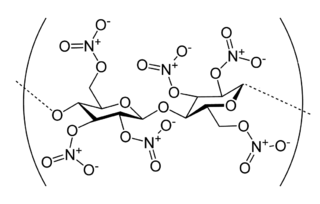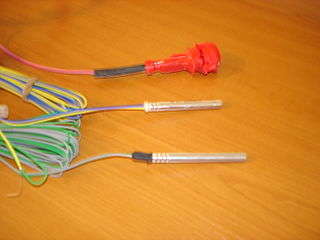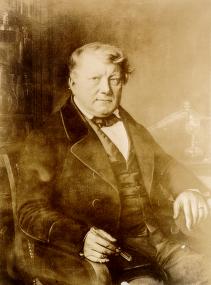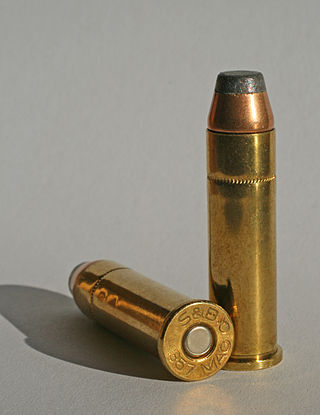Related Research Articles

Gunpowder, also commonly known as black powder to distinguish it from modern smokeless powder, is the earliest known chemical explosive. It consists of a mixture of sulfur, carbon and potassium nitrate (saltpeter). The sulfur and carbon act as fuels while the saltpeter is an oxidizer. Gunpowder has been widely used as a propellant in firearms, artillery, rocketry, and pyrotechnics, including use as a blasting agent for explosives in quarrying, mining, building pipelines and road building.

Cordite is a family of smokeless propellants developed and produced in Britain since 1889 to replace black powder as a military firearm propellant. Like modern gunpowder, cordite is classified as a low explosive because of its slow burning rates and consequently low brisance. These produce a subsonic deflagration wave rather than the supersonic detonation wave produced by brisants, or high explosives. The hot gases produced by burning gunpowder or cordite generate sufficient pressure to propel a bullet or shell to its target, but not so quickly as to routinely destroy the barrel of the gun.

Nitrocellulose is a highly flammable compound formed by nitrating cellulose through exposure to a mixture of nitric acid and sulfuric acid. One of its first major uses was as guncotton, a replacement for gunpowder as propellant in firearms. It was also used to replace gunpowder as a low-order explosive in mining and other applications. In the form of collodion it was also a critical component in an early photographic emulsion, the use of which revolutionized photography in the 1860s.

A detonator, sometimes called a blasting cap in the US, is a small sensitive device used to provoke a larger, more powerful but relatively insensitive secondary explosive of an explosive device used in commercial mining, excavation, demolition, etc.
A muzzleloader is any firearm into which the projectile and the propellant charge is loaded from the muzzle of the gun. This is distinct from the modern designs of breech-loading firearms. The term "muzzleloader" applies to both rifled and smoothbore type muzzleloaders, and may also refer to the marksman who specializes in the shooting of such firearms. The firing methods, paraphernalia and mechanism further divide both categories as do caliber.

Christian Friedrich Schönbein HFRSE(18 October 1799 – 29 August 1868) was a German-Swiss chemist who is best known for inventing the fuel cell (1838) at the same time as William Robert Grove and his discoveries of guncotton and ozone.

A shell, in a military context, is a projectile whose payload contains an explosive, incendiary, or other chemical filling. Originally it was called a bombshell, but "shell" has come to be unambiguous in a military context. Modern usage sometimes includes large solid kinetic projectiles, which are more properly termed shot. Solid shot may contain a pyrotechnic compound if a tracer or spotting charge is used.

A centerfire cartridge is a firearm metallic cartridge whose primer is located at the center of the base of its casing. Unlike rimfire cartridges, the centerfire primer is typically a separate component seated into a recessed cavity in the case head and is replaceable by reloading.

In an explosive, pyrotechnic device, or military munition, a fuse is the part of the device that initiates function. In common usage, the word fuse is used indiscriminately. However, when being specific, the term fuse describes a simple pyrotechnic initiating device, like the cord on a firecracker whereas the term fuze is used when referring to a more sophisticated ignition device incorporating mechanical and/or electronic components, such as a proximity fuze for an M107 artillery shell, magnetic or acoustic fuze on a sea mine, spring-loaded grenade fuze, pencil detonator, or anti-handling device.

Smokeless powder, also referred to as gunpowder, is a type of propellant used in firearms and artillery that produces less smoke and less fouling when fired compared to black powder. The combustion products are mainly gaseous, compared to around 55% solid products for black powder. In addition, smokeless powder does not leave the thick, heavy fouling of hygroscopic material associated with black powder that causes rusting of the barrel.
Poudre B was the first practical smokeless gunpowder created in 1884. It was perfected between 1882 and 1884 at "Laboratoire Central des Poudres et Salpêtres" in Paris, France. Originally called "Poudre V" from the name of the inventor, Paul Vieille, it was arbitrarily renamed "Poudre B" to distract German espionage. "Poudre B" is made from 68.2% insoluble nitrocellulose, 29.8% soluble nitrocellulose gelatinized with ether and 2% paraffin. "Poudre B" is made up of very small paper-thin flakes that are not white but dark greenish grey in colour. "Poudre B" was first used to load the 8mm Lebel cartridges issued in 1886 for the Lebel rifle.

Hang fire refers to an unexpected delay between the triggering of a firearm and the ignition of the propellant. This failure was common in firearm actions that relied on open primer pans, due to the poor or inconsistent quality of the powder, although modern firearms are also susceptible. The delay is usually too brief to be noticed, but can be several seconds. A hangfire should be suspected whenever a firearm fails to fire, but has not clearly malfunctioned.
Hercules, Inc. was a chemical and munitions manufacturing company based in Wilmington, Delaware, United States, incorporated in 1912 as the Hercules Powder Company following the breakup of the DuPont explosives monopoly by the U.S. Circuit Court in 1911. Hercules Powder Company became Hercules, Inc. in 1966, operating under this name until 2008, when it was merged into Ashland Inc.
Barwick, Great Barwick, and Little Barwick are hamlets in the civil parish of Standon in Hertfordshire, England. They are near the A10 road and the village of Much Hadham and the hamlet of Latchford. The River Rib flows behind Barwick and through Great Barwick. There is a ford crossing at Great Barwick.

A powder mill was a mill where gunpowder is made from sulfur, saltpeter and charcoal.
The safety fuse is a type of fuse invented and patented by English inventor William Bickford in 1831. Originally it consisted of a "tube" of gunpowder surrounded by a waterproofed varnished jute "rope." It replaced earlier and less reliable methods of igniting gunpowder blasting charges which had caused many injuries and deaths in the mining industry. The safety fuse burns at a rate of typically about 30 seconds per foot.

California Powder Works was the first American explosive powder manufacturing company west of the Rocky Mountains. When the outbreak of the Civil War cut off supplies of gunpowder to California's mining and road-building industries, a local manufacturer was needed. Originally located near Santa Cruz, California, the company was incorporated in 1861 and began manufacturing gunpowder in May 1864. For 50 years, it was a major employer in the county, employing between 150 and 275 men. The powder works was located on a flat adjacent to the San Lorenzo River, three miles upstream of Santa Cruz.
In firearms and artillery, the primer is the chemical and/or device responsible for initiating the propellant combustion that will propel the projectiles out of the gun barrel.

Laflin & Rand Powder Company was a gunpowder and early smokeless powder manufacturer notable for producing the smokeless powder used by United States Army infantry rifles from 1896 to 1908, which included the period of development of the M1903 Springfield rifle and .30-06 Springfield cartridge.
In 1888 the 'Smokeless Powder Company', owned by James Dalziel Dougall Junior, the son of the famous glaswegian gunsmith -J D Dougall, took a 99-year lease for 126 arces around 'The Outpost', from the Youngsbury Estate. The site's name was changed from 'The Outpost' to Barwick and Barwick was formed as a 'factory hamlet'.
References
- Buchanan, B.J. (2016). Gunpowder, Explosives and the State: A Technological History. Taylor & Francis. ISBN 978-1-351-93190-8 . Retrieved 2022-07-12.